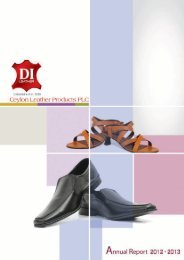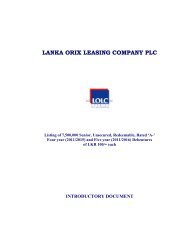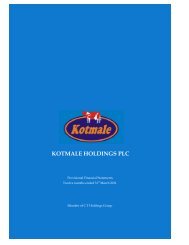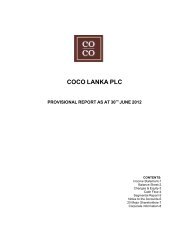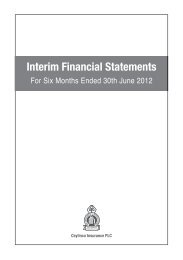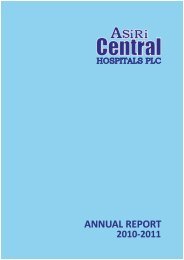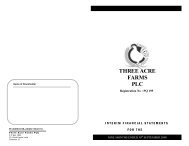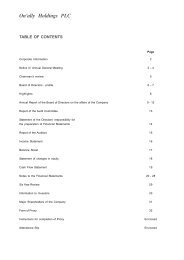Annual Report 2010-2011 - Colombo Stock Exchange
Annual Report 2010-2011 - Colombo Stock Exchange
Annual Report 2010-2011 - Colombo Stock Exchange
You also want an ePaper? Increase the reach of your titles
YUMPU automatically turns print PDFs into web optimized ePapers that Google loves.
Notes to the Financial Statements Contd.<br />
asset is required, the Group makes an estimate of the asset’s<br />
recoverable amount. An asset’s recoverable amount is the<br />
higher of an asset’s or cash generating unit’s fair value less<br />
costs to sell and its value in use and is determined for an<br />
individual asset, unless the asset does not generate cash<br />
inflows that are largely independent of those from other assets<br />
or groups of assets. Where the carrying amount of an asset<br />
exceeds its recoverable amount, the asset is considered<br />
impaired and is written down to its recoverable amount. In<br />
assessing value in use, the estimated future cash flows are<br />
discounted to their present value using a pre-tax discount rate<br />
that reflects current market assessments of the time value of<br />
money and the risks specific to the asset.<br />
Impairment losses are recognized in the income statement<br />
except for impairment losses in respect of property, plant<br />
and equipment which are recognized against the revaluation<br />
reserve to the extent that it reverses a previous revaluation<br />
surplus.<br />
An assessment is made at each reporting date as to whether<br />
there is any indication that previously recognized impairment<br />
losses may no longer exist or may have decreased. Previously<br />
recognized impairment losses other than in respect of<br />
goodwill, are reversed only if there has been an increase in the<br />
recoverable amount of the asset. Such increase is recognized<br />
to the extent of the carrying amount had no impairment losses<br />
been recognized previously.<br />
2.4.7 Inventories<br />
Inventories other than produce inventories are valued at<br />
the lower of cost and net realizable value after making due<br />
allowances for obsolete and slow moving items. Net realizable<br />
value is the estimated selling price less estimated costs of<br />
completion and the estimated costs necessary to make the sale.<br />
The costs incurred in bringing inventories to its present location<br />
and condition, are accounted for as follows:<br />
a) Raw materials<br />
At actual cost on first-in first-out basis and weighted average<br />
cost<br />
b) Work-in- progress<br />
At the cost of direct materials, direct labour and an appropriate<br />
proportion of production overheads based on normal operating<br />
capacity.<br />
c) Finished goods<br />
At purchase cost and /or cost of direct materials, direct labour<br />
and an appropriate proportion of production overheads based<br />
on normal operating capacity.<br />
d) Goods in transit<br />
At actual cost<br />
e) Produce inventories<br />
At since realized price<br />
2.4.8 Trade and other receivables<br />
Trade and other receivables are stated at the amounts they are<br />
estimated to realize, net of allowances for bad and doubtful<br />
receivables.<br />
Allowances have been made for bad and doubtful debts. Bad<br />
debts are written off when identified.<br />
2.4.9 Cash and cash equivalents<br />
Cash and cash equivalents in the cash flow statement<br />
comprise cash at bank and in hand and short term deposits<br />
with a maturity of 3 months or less, net of outstanding bank<br />
overdrafts and short term borrowings.<br />
2.5 LIABILITIES AND PROVISIONS<br />
2.5.1 Employee Benefit Liabilities<br />
a) Defined benefit plan – Gratuity<br />
The Group measures the present value of the promised<br />
retirement benefits of gratuity, which is a defined benefit plan<br />
using Projected Unit Credit method (PUC).<br />
The services of a qualified actuary is obtained to determine the<br />
valuation once in every 2 years for plantation companies and<br />
every 3 years for other companies in the group.<br />
Actuarial gains and losses are recognized as income or<br />
expenses immediately.<br />
This item is stated under Employee Benefit Liabilities in the<br />
Balance Sheet.<br />
The basis of payment of retiring gratuity as follows:<br />
Length of<br />
service<br />
(years)<br />
No. of months<br />
salary for each<br />
completed year<br />
of service<br />
00-04 0<br />
05-10 ½<br />
11-20 ¾<br />
21-30 1<br />
Over 30<br />
1 ¼<br />
b) Defined contribution plans - Employees’ Provident<br />
Fund and Employees’ Trust Fund<br />
Employees are eligible for Arpico Employees’ Provident Fund<br />
Contributions / Employees’ Provident Fund Contributions and<br />
Employees’ Trust Fund Contributions in line with the respective<br />
Statutes and Regulations. The Companies contribute 12%<br />
and 3% of gross emoluments of employees to the Arpico<br />
Richard Pieris and Company PLC | <strong>Annual</strong> <strong>Report</strong> <strong>2010</strong>/<strong>2011</strong> 72





